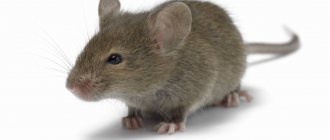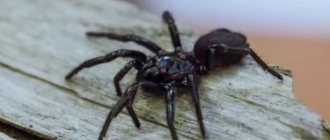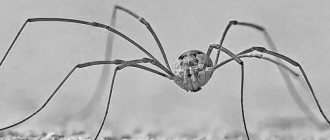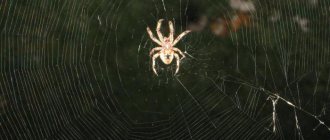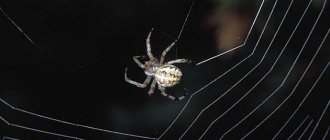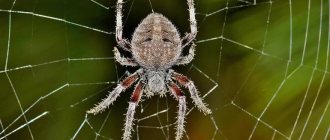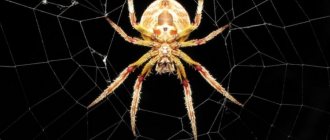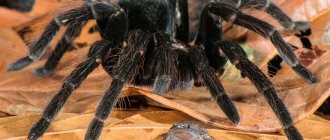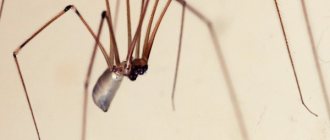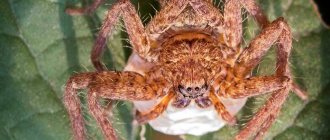An insect that each of us has encountered at least once in our lives is the hay spider. It is distinguished by very long thin legs and a distinctive elongated or spherical body. The insect belongs to the spider family, araneomorpha order. This includes more than 1,000 species, but most representatives prefer hot conditions and live in the tropics. In Russia, the hay spider often lives in houses and apartments. In the article we will find out whether it poses a danger to humans, whether it is poisonous or not, what it eats and what it looks like.
The haymaker spider in the photo
The haymaker spider does not hibernate, but is active throughout the year. This is due to the fact that the first representatives of the family lived in the tropics, which are not characterized by seasonality. This ancient feature has also been preserved among spiders living in Russia. Therefore, their clutches of eggs can be found in apartments and houses even in the depths of winter.
If you look at what the haymaker spider looks like in the photo, it becomes clear why it was called that. Among the characteristic external signs it is worth highlighting the following:
- spherical or elongated body;
- spiders with an elongated body have a clear division into the abdomen and cephalothorax;
- sizes vary from 2 mm to 1 cm;
- average leg length from 3 to 5 cm;
- 4 pairs of limbs with false segmentation;
- lateral and large medial eyes.
The appearance of the spider differs depending on its lifestyle and habitat. The greatest differences are observed in the length of the legs. In most representatives of wildlife, the limbs match or sometimes exceed the size of the body. Very long legs are a characteristic feature of hay spiders living in apartments. Representatives living in caves have only three pairs of lateral eyes, the medial ones are absent.
Interesting fact
An interesting fact is related to the peculiarities of the movement of hay spiders and their reaction to danger. During movement, individuals do not touch the surface with their body, and if they feel threatened, they can easily leave numerous limbs. The site of injury quickly heals, but the nerve endings create reflex muscle twitches within 30 minutes. Lost legs cannot be restored.
Population and species status
Photo: Poisonous harvest spider
Harvesting spiders live in almost every house on our planet - from this it is already obvious that their population is very large and is not in danger. These are very tenacious creatures that cannot be harmed by environmental deterioration or other factors, due to which other living organisms are sometimes at risk of extinction.
But this applies to synanthropic species - they have perfectly adapted to coexistence with humans and, due to this, expanded their habitat. But those remaining to live in the wild may become more rare – this is evidenced by the fact that more and more new species are being discovered in the far corners of the planet.
Their range can be limited to very small areas, and there are species that live in only one region, usually located in the tropics. However, they are not in danger of extinction due to the fact that spiders are well adapted and survive even in the harshest conditions.
And it may be necessary to drive it out due to the fact that, although the harvest spider is harmless to humans, its webs can be annoying. But it should be taken into account that these spiders very effectively fight other small domestic animals, and therefore after disappearing they can proliferate greatly, and think again whether a spider or two is really bothering you.
The harvest spider is a harmless and even useful inhabitant of houses. They fight other harmful living creatures, the main thing is that there are not too many of them themselves, because then their web will be everywhere. There are many different species of these spiders, sometimes their representatives bear little resemblance to each other, and some live only in the wild.
Tags:
- Haplogynae
- Neocribellatae
- Opisthothelae
- Panarthropoda
- Pholcoidea
- Araneomorph spiders
- Big spiders
- Bilaterally symmetrical
- Animals of Australia
- Animals of Australia and Oceania
- Animals of Africa
- Animals of Venezuela
- Animals of Greenland
- Animals of Eurasia
- Animals of Indonesia
- Animals of Malaysia
- Animals starting with the letter P
- Animals starting with the letter C
- Animals of New Guinea
- Animals of Oman
- Animals of Russia
- Animals of North America
- Animals of the Subtropical Zone of the Northern Hemisphere
- Animals of the Subtropical Zone of the Southern Hemisphere
- Animals of the Subequatorial Belt of the Northern Hemisphere
- Animals of the Subequatorial Belt of the Southern Hemisphere
- Animals of the tropics
- Rainforest Animals
- Rainforest Animals
- Animals of the Tropical Zone of the Northern Hemisphere
- Animals of the Tropical Zone of the Southern Hemisphere
- Animals of the Temperate Zone of the Northern Hemisphere
- Animals of the Temperate Zone of the Southern Hemisphere
- Animals of South America
- Shedding
- Spiders
- Spiders of Russia
- Spiders of central Russia
- Harvesting spiders
- Protostomes
- The most disgusting spiders
- Scary spiders
- Tropical animals
- Cheliceraceae
- Arthropods
- Eukaryotes
- Eumetazoans
- Poisonous spiders
- Poisonous spiders in Russia
What do hay spiders eat?
The harvester uses a web to hunt prey. But unlike the webs that other spiders weave, it is non-sticky. The harvester's web is chaotic, tangled, with an uneven pattern. It can be seen:
- among the branches of small trees and bushes;
- in caves;
- in thickets and grass;
- in abandoned animal holes;
- in apartments and houses;
- in empty buildings.
What do hay spiders eat? The main diet is small insects, other spiders, larvae and eggs. The insect is able to estimate the size of a potential victim. If it is too large, then he acts in two scenarios:
- A large insect was trapped.
The owner of the web can help you get out of the web by biting through a few threads or shaking them. - A large prey is approaching the web.
The harvester begins to quickly untangle or shake the net so that the insect avoids the obstacle and does not get caught and damage the trap.
In winter, the number of potential prey and the volume of food sources becomes significantly smaller, as many species hibernate. To survive, the harvestman goes in search of another spider's trap and pretends to be caught in the web. When another spider approaches, the harvester attacks it.
Reproduction
At the end of summer, the mating season begins for the haymakers. They completely lack marriage rituals. Having met a sexually mature female, the spider quickly mates and goes about its business.
The female lays up to 50 eggs. She places them in a cocoon one at a time or in small piles under fallen leaves, in moss or simply in loose soil. She carries out this procedure using the ovipositor located in the lower part of the abdomen.
The period between clutches ranges from several days to 3 weeks. The eggs remain dormant throughout the winter.
With the onset of spring, small spiders emerge from them, which immediately scatter in different directions. The young quickly adapt to the environment, and with the arrival of autumn they are already capable of giving birth to a new generation of hay spiders.
What do hay spiders eat?
What do hay spiders eat? The main diet consists of flies, ants, mites and beetles. In conditions of prolonged absence of food, individuals can attack members of their own species. This is especially common in winter.
The haymaker spider is predominantly nocturnal. During the hunt, he attaches a signal thread to one of his limbs, after which he slides down head down and waits for the prey. An insect, once caught in a net, instantly becomes entangled due to the chaotic weaving. At this time, vibration reaches the spider along the signal thread, which indicates a successful hunt. It rises to the prey, entangles it with additional threads, which will definitely not allow the victim to free himself from the web. It turns out to be a kind of dense cocoon. The harvestman bites through the shell, releases gastric juices, which gradually transform the internal contents of the cocoon, including the chitinous shell, into a single liquefied mixture. If the predator is not hungry, it leaves the prey as a reserve. Otherwise, it eats the prey immediately.
Myths and confusion
Some people believe that the hay spider is poisonous, meaning the hay spider. You can hear another version of the judgment that these creatures have very strong poison, but cannot bite through human skin. Let's try to figure out if this is really the case.
You should immediately pay attention to the definition. The harvestman is not a spider. The pigtail belongs only to the order of arachnids
Another thing is the haymaker spider. It is also popularly called centipede. This representative really belongs to the order of spiders. It bears a vague resemblance to a haymaker, mainly due to the length of its legs, but has a different lifestyle: it weaves nets, catches insects in them and has glands with poison, which it uses to kill its victims.
The pigtail belongs only to the order of arachnids. Another thing is the haymaker spider. It is also popularly called centipede. This representative really belongs to the order of spiders. It bears a vague resemblance to a haymaker, mainly due to the length of its legs, but has a different lifestyle: it weaves nets, catches insects in them, and has glands with poison, which it uses to kill its victims.
How to get rid of hay spiders
The presence of spiders in the house is unlikely to bring positive emotions to anyone. And if they begin to appear frequently and in large quantities, the apartment owners have a logical question: “How to get rid of hay spiders? What effective insect control methods can be used?
At the first stage, it is necessary to inspect all possible habitats of adult individuals. In apartments and residential buildings, they usually hide in dark corners or near windows. Haymakers prefer to settle in places with little humidity. Getting rid of spiders consists of two stages - cleaning and repelling.
Cleaning stage:
- close all openings through which a spider can crawl;
- replace the ventilation grille with a similar product with a minimum cell size;
- use mosquito nets on windows;
- To prevent spiders from being attracted to bright light, you can install blinds or dark roller blinds, replace white lamps with yellow ones;
- Regular cleaning and inspection of hard-to-reach places will allow you to timely detect cobwebs and grasshoppers and prevent their reproduction.
When wet cleaning, special attention should be paid to the space under the bed, behind the sofa and closet, and in the corners.
As a preventative measure, you can use a humidifier to repel hay spiders. These insects do not like moisture. But you should be careful not to attract other parasites and pests into your home. But the main factor regulating the number of harvesters is the availability of a food source. If the apartment is not inhabited by potential victims of the spider, it will not weave a web in such a place. Strong odors can also be used as deterrents:
- eucalyptus;
- mint;
- tea tree;
- citrus fruits;
- hazelnuts, chestnuts.
You can also use chemical insect control agents. They are presented in a wide range in special departments of stores. To professionally combat spiders, seek help from specialists. They will quickly treat the room and get rid of unwanted insects in the house forever. To call a team, contact a company consultant by phone.
Calculator
Funny classification
Among lovers of large tarantula spiders, there is an interesting division of pets into categories according to their speed characteristics:
- For beginners. Slow spiders that people like to show on video. These arthropods sit calmly on the palm, and if they try to escape, they move slowly.
- For the advanced. If the spider of this group decides to escape, then the owner can only notice the direction in which the animal disappeared.
- For professionals. The escape of a spider is noticed by its absence from the place where it was just sitting. Where it went is known only to the arthropod itself.
The last group suggests that not all spider breeds have been discovered by scientists yet. It's hard to see a fast spider if you don't even know it's there.
Centipedes (as they are called informally) are representatives of araneomorphs. The family is divided into 80 genera. Among them are many synanthropes, common in human homes in almost all countries.
Natural enemies
In the wild, spiders have many natural enemies. They form part of the diet of many predators. That is why haymakers tend to settle in human dwellings, where there is almost no threat to them. Natural enemies:
- rodents;
- birds;
- snakes;
- lizards;
- toads.
Although some pets also pose a danger to spiders. Cats and dogs hunt for them not to eat them, but for the sake of interest and fun. But over time, the pets stop paying attention to them, and the haymakers remain safe.
In apartments, other spiders remain their enemies. They may belong to other families or be brothers. Some mushrooms of the genus Cordyceps also become a problem for thin-legged mushrooms. They infect the spider's body and gradually grow inside it. All internal organs are affected and slowly destroyed, causing the arthropod to die. The fungi break through and eat the spider completely, not even its chitinous covering remains.
Although most species of harvestmen have non-sticky nets, some use a special glue. It is secreted by hairs located on the pedipalps. This composition allows you to instantly capture the victim. The spider only needs to touch it once to stick it to its paws.
Name
People also call these arachnids “braids”. They got it because of the structural features of the limbs. The fact is that the severed leg of the haymaker continues to move for some time. They vaguely resemble the mowing process.
Losing a limb is not fatal. It is believed that the harvester (spider) cuts it off himself in order to escape from danger on his remaining legs. The wound quickly becomes clogged and the liquid internal environment of the arachnid (hemolymph) does not flow out.
There is another aspect to this behavior. The attacker, left with a twitching paw, will be busy for some time observing the “mowing” process, which will give its owner the opportunity to try to escape to a safe distance with the remaining limbs and have time to use additional means of defense.
Special Features
If you grab a haymaker's leg, it will easily come off. For a few more minutes, the severed limb will make convulsive movements.
The ease with which the limb comes off creates the misleading impression that the legs are loosely attached to the body. In fact, this is not true. The harvester deliberately separates the limb. The paw comes off like a lizard's tail. This autotomy helps the haymakers to escape from enemies.
The predator first stumbles upon the paws, and then is distracted by the moving limb while the animal flees. Therefore, you can often find individuals who have an incomplete number of legs.
Lifestyle
Most species are nocturnal predators. During the day they freeze in secluded places. Pets are hiding in the corners. Sometimes they can be seen frozen on the walls. A timid animal that immediately tries to hide when encountered.
Like all predators, they feed on animal food. The diet includes caterpillars, ants, mosquitoes, and various beetles. There are species that easily cope with snails. Some moss moths eat mushrooms, moss and other plant foods.
The structure of the oral apparatus allows it to absorb solid particles of prey. Food is crushed by pidipalps, which act as jaws.
Features of the view
Scientists know little about the evolution of arachnids. They have been living on the planet for millions of years, and their ancestors were creatures that lived in the sea. They were the first to emerge from the water and adapt to life on land. And one of the most important means for survival was the web. Almost every decade a new species of arthropod appears, so there are almost no ancient ones left.
The family of harvestmen appeared about 2 million years ago. It was first described by K. L. Koch in 1850. It has 94 genera, but even today new subspecies appear. Most live in the tropics, but in countries with temperate climates you can also find the braided one.
Habitats
The spider lives almost throughout the entire planet. It was not found only in the coldest regions - Antarctica and the Arctic. But he can live wherever there is a person. In the northern regions, arthropods do not survive outside houses and apartments. They get used to warmth and comfort, they like dry rooms and constant availability of food.
In the wild, the spider is found in the tropics, where the climate is hot and humid. Slightly fewer individuals live in subtropical zones; sometimes they can be seen in temperate latitudes. And in cold regions, spiders hide in human dwellings; they are practically never found on the street.
In nature, arthropods occupy caves, crevices in old collapsed buildings, holes in trees, shelters between stones. But such places must be heated and well protected from moisture. At home they choose dry and warm places. In apartments, the haymaker settles behind radiators or in corners under the ceiling. He avoids bright light as his eyes are accustomed to darkness.
Due to the interesting body structure, the spider's movements are unusual. While walking, it combines hydraulic and mechanical principles. The paws bend due to muscle contraction. But they straighten due to the pumping of hemolymph. This movement allows the arthropod to save energy.
Settlement area
It's time to find out where these amazing creatures live. Haymakers settled almost everywhere, occupying various natural landscapes.
The main species have chosen forests and meadows. They are found in mountain ranges, settling in rock crevices and caves. Some species have easily adapted to living conditions in cities, and therefore can be found in apartments, houses, and office premises.
